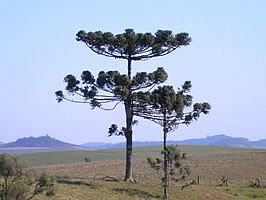The Parana Pine (Araucaria angustifolia), a symbol of the state of Paraná in Brazil, is renowned for its beauty, ecological role, and utility to humans. This conifer, from the Araucariaceae family, stands out not just for its ornamental features but also for its critical role in the ecosystems it inhabits. Despite these qualities, it is an endangered species, classified as “Critically Endangered” by the International Union for Conservation of Nature (IUCN), primarily due to habitat loss and logging.
This tree is quite large, reaching heights of 50 meters (about 164 feet). It is distinct from other pines in its candelabra-like structure, an evolutionary adaptation for better sunlight capture. It has a straight, cylindrical trunk, and in its youth, displays a pyramidal crown like other conifers, making it an excellent Christmas tree. Over the years, lower branches fall off, resulting in a flatter, more open crown, resembling a candelabra, with branch tips pointing upwards.
The outer bark is brownish-gray, resinous, rough, and flaky, with intermittent vertical grooves and horizontal lines. Over time, the bark peels off in small plates, revealing reddish patches of the inner bark. The main branches (grimpas) are whorled and horizontally disposed, while secondary branches vary from alternate to whorled, clustering at the ends of the main leaves. The leaves are simple, alternate, spirally arranged, and vary from ovate to lanceolate, measuring 3 to 6 cm (about 1.2 to 2.4 inches) in length and 0.6 to 1 cm (about 0.24 to 0.39 inches) in width. Dark green or glaucous, the leaves have a thick texture but are flexible, with stomata on the upper surface in sterile branches and on the lower in fertile branches.
Individuals can be male or female (dioecious), a trait that distinguishes the Parana Pine from many other pines which are hermaphroditic. Male cones are sub-cylindrical and axillary, varying from 8 to 15 cm (about 3.1 to 5.9 inches) in length and 1.5 to 3 cm (about 0.59 to 1.18 inches) in width, while female cones are apical, erect, ovoid to globular, and about 14 to 16 cm (about 5.5 to 6.3 inches) in diameter. After wind pollination (anemophily), they mature slowly (2 to 3 years). The resulting seeds, pine nuts, are large, wedge-shaped, light brown, about 5 x 2 cm (about 2 x 0.79 inches), with an apical appendage and narrow wings. These seeds are a significant food source for various species, including birds, wild and domestic animals, and humans, playing a vital role in the local food chain.
The pine nut is notable for its distinct flavor and nutritional value. With a mild, slightly sweet taste reminiscent of a mix between potatoes and chestnuts, the pine nut is versatile in cooking and a rich source of nutrients. Nutritionally, it is an excellent source of complex carbohydrates, fibers, proteins, and unsaturated fatty acids, and contains vitamins and minerals such as vitamin E, B vitamins, calcium, and potassium. In cooking, the pine nut is often boiled or roasted and eaten plain as a snack or incorporated into a variety of traditional dishes like soups, risottos, farofas, and even desserts. Its versatility and unique flavor make it a favorite ingredient in regional festivals, especially in winter, when it is harvested.
Beyond its food value, Parana Pine wood is quite useful. The wood is considered light and moderately soft, suitable for a wide range of uses, including construction, furniture making, and crafts. Additionally, its pine knot, characterized by a dense, hard formation in the wood where a branch was inserted, is widely used in carpentry and decoration, prized for its unique texture and rustic appearance, lending a special touch to furniture, panels, and handmade pieces. The pine knot is also highly valued as firewood for fireplaces, due to its slow burning.
This species is recommended for reforestation throughout southern Brazil, where its cultivation can aid in the recovery of degraded areas. Reforestation with Parana Pine trees also contributes to maintaining local biodiversity, providing habitat for many native species.
In Brazil, cutting Parana Pine trees is strictly controlled and, in many cases, prohibited. Brazilian environmental legislation, through IBAMA (Brazilian Institute of the Environment and Renewable Natural Resources) and the Forest Code, imposes severe restrictions on cutting these trees, seeking to preserve the remnants of these forests. Only in specific situations, with proper authorization from environmental agencies and under strict conditions, is the handling or cutting of Parana Pine allowed. These measures aim not just to conserve the species, but also to protect the associated biodiversity and maintain ecological balance in the regions where this tree is native.
To cultivate Parana Pine, some care is necessary. Initially, they should be grown in partial shade for rapid growth in the early years, and then gradually exposed to full sun, as in natural forest conditions. The Paraná pine is a demanding tree, thriving in fertile, deep soils and not doing well in very moist soils. It is tolerant of cold and frosts, reflecting its adaptation to the climatic conditions of southern Brazil. The species is propagated by seeds, a process that can be facilitated by controlled germination techniques.
Besides its ecological and economic value, the Parana Pine has a strong cultural connection with the southern region of Brazil. Its presence is a symbol of regional identity, evident in traditional festivals and local cuisine. Thus, the preservation of the Parana Pine is not only an environmental issue but also a cultural one, underscoring the importance of conservation efforts.


